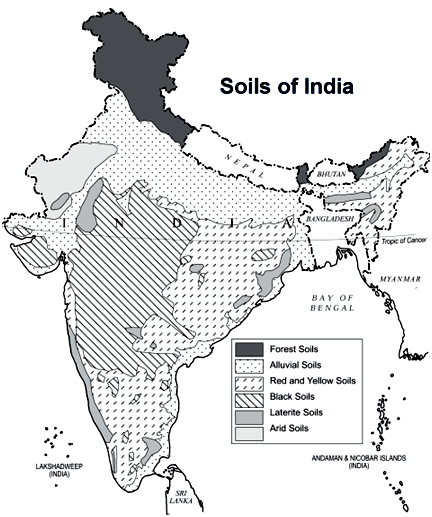Alluvial Deposits:
Soils left behind by rivers are called alluvial deposits. It contains a lot of organic stuff as well as silt, sand, clay, and gravel. Alluvial deposits can form whenever a river exceeds its banks or where its flow is restricted, but they are often most prevalent in the bottom section of a river’s course.
In the Indo-Gangetic plain, which stretches from Punjab in the west to West Bengal and Assam in the east, as well as in the coastal regions of the northern parts of Gujarat, Narmada, and Tapi valleys, which are formed by sea waves, the majority of alluvial soils are derived from the sediment being deposited by the river Ganga.
According to its age, alluvial soil can be divided into two groups: khaddar and bhangar. Depending on the depth of deposition, the texture of the materials, and the length of time required for maturation, the colour of alluvial soils ranges from light grey to ash grey.
Alluvial soil has a lot of humus and is fertile, which are its main benefits. They are very useful for agriculture and are abundant in potassium.
Black Cotton Soils:
Black cotton soil is made up primarily of clay and can range in hue from light to dark grey. It is a type of soil created in the Indian Deccan by the breakdown of black lava.
By appearance, the black cotton soil appears to be of a dark colour, and a sample test reveals that it exhibits the behaviour of expanding when wet and contracting when dry. Black soils have a high proportion of calcium and magnesium carbonates, are very fine-grained, very argillaceous, and are dark. When wet, they become extremely sticky and moisture tenacious. Large and deep cracks emerge as a result of significant contraction after drying.
As a result, Black Cotton Soil (BC Soil) has a very poor bearing capacity as well as significant features of swelling and shrinkage. It makes a very poor foundation material for roads due to its unusual properties. Black Cotton soils typically have soaked laboratory CBR values in the 2 to 4 percent range.
Although black soil has low nitrogen levels, it is rich in calcium, potassium, and magnesium.
It supports the growth of crops like cotton, tobacco, chiles, oil seeds, jowar, ragi, and maize.
Lateritic Soils:
It is generally accepted that hot, humid tropical regions are where laterite, a type of soil and rock rich in iron and aluminium, developed. Due to their high iron oxide concentration, nearly all laterites are rusty-red in hue. They form as a result of the parent rock’s extensive and continuous weathering. The hilly regions of Orissa and Assam as well as Karnataka, Kerala, Tamil Nadu, and Madhya Pradesh frequently have laterite soils. Due to the presence of iron oxide, soil has a reddish brown tint.
Desert Soil:
In areas with little rainfall, desert soil makes up 90–95 percent of the soil. It is infertile because it contains relatively little nitrogen and organic matter and a lot of calcium carbonate and phosphate. In comparison to the topsoil, the lower layer contains ten times more calcium.
Aridisols are the common name for desert soils (dry soil). However, the soil orders are known as Entisols in extremely arid areas of the Sahara and the Australian outback. New soils called entisols, which resemble sand dunes, are too dry to support significant horizon development.
Hot and dry deserts, semiarid deserts, coastal deserts, and cold deserts are the four basic types of deserts. Arid deserts, usually referred to as hot and dry deserts, have year-round warm temperatures.
Marine Deposits:
Any accumulation of insoluble material, primarily rock and soil particles, that has been carried from land to the ocean by wind, ice, and rivers, as well as any marine animals’ remains, byproducts of undersea volcanism, chemical precipitates from saltwater, and objects from space.
Lithogenous, biogenous, hydrogenous, and cosmogenous are the four different types of marine sediments. Lithogenous are formed on the surface of the earth and are made up of tiny fragments of worn rock and volcanic activity.

